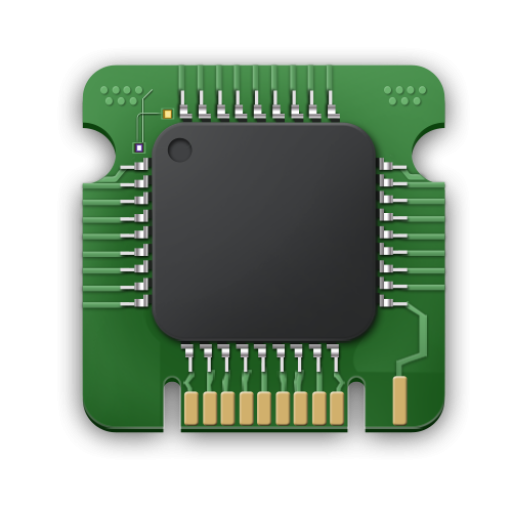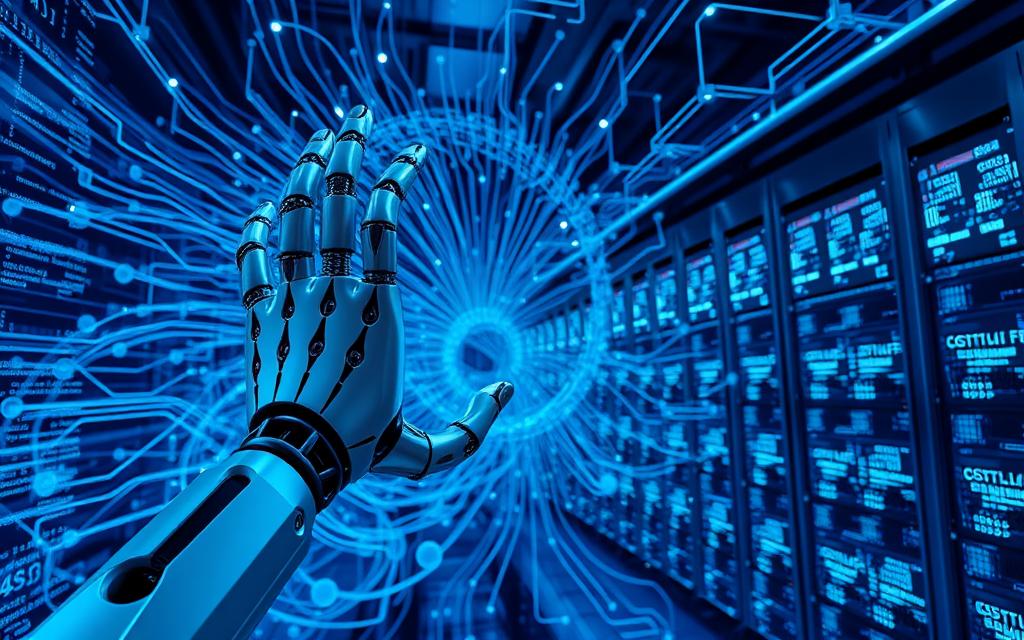Artificialintelligenceis revolutionizing the way we live and work. As a set oftechnologiesthat enable computers to perform advanced functions,intelligencesystems are becoming increasingly integral to modern computing.
These systems can see, understand, and translate spoken and written language, analyze data, and make recommendations. By unlocking value for individuals and businesses, artificial intelligence is the backbone of innovation.
To understand the significance of intelligence in today’s world, it’s essential to explore how these systems process and analyze data to perform tasks that typically require human intelligence. For more information on artificial intelligence, you can visit the provided link.
Understanding AI Technology: A Comprehensive Definition
At its core, artificial intelligence is about building machines that can reason, learn, and act in ways that would normally require human intelligence. This involves creating computer systems capable of performing tasks that typically require human intelligence, such as visual perception, speech recognition, decision-making, and language translation.
Evolution of AI
The evolution of artificial intelligence has progressed from simple rule-based systems to sophisticated learning algorithms that can improve their performance over time without explicit programming. This evolution has enabled AI technology to become increasingly adept at processing and analyzing large volumes of data, recognizing patterns, and making predictions.
Key Characteristics
Key characteristics of AI systems include their ability to process and analyze large volumes of data, recognize patterns, make predictions, and in some cases, adapt to new information. Modern AI technology encompasses various approaches, including rule-based systems, machine learning, and neural networks, each with distinct capabilities and applications.
- AI can perform tasks that typically require human intelligence.
- The technology involves creating computer systems capable of complex tasks.
- AI systems can process and analyze large volumes of data.
The History and Development of AI
The history of artificial intelligence is a rich tapestry of innovation and discovery. The term “artificial intelligence” was coined in 1956 by computer scientist John McCarthy for a workshop at Dartmouth. However, the conceptual foundations were laid earlier by pioneers like Alan Turing.
Foundational Concepts
Early concepts in AI research included Alan Turing’s groundbreaking work in the 1950s, including the famous “Turing Test” designed to evaluate a machine’s ability to exhibit intelligent behavior equivalent to human intelligence. The formal history of AI began at the Dartmouth Conference, marking the beginning of AI as a field of computer science research.
- The development of AI has experienced cycles of optimism followed by “AI winters.”
- Recent breakthroughs have been driven by advances in computing power and innovations in neural networks.
Modern Advancements
Recent breakthroughs in AI technology have been driven by advances in computing power, the availability of massive datasets, and innovations in neural network architectures and deep learning algorithms. The evolution from symbolic AI to modern machine learning approaches represents a fundamental shift in how computer science approaches the creation of intelligent systems.
| Year | Event | Significance |
|---|---|---|
| 1950 | Alan Turing proposes the Turing Test | Evaluating a machine’s ability to exhibit intelligent behavior |
| 1956 | The term “artificial intelligence” is coined | Marking the beginning of AI as a field of research |

How Does AI Technology Work?
At its core, AI technology relies on a synergy of data, algorithms, and models to facilitate machine learning and intelligent decision-making. This complex interplay enables AI systems to process vast amounts of data, identify patterns, and make informed decisions or predictions.
The Building Blocks: Data, Algorithms, and Models
AI technology functions through the integration of three essential components: data that serves as the foundation for learning, algorithms that process this information, and models that represent the learned patterns. The quality and quantity of data are crucial factors in AI development, as systems require vast amounts of relevant information to identify patterns and make accurate predictions.
- Algorithms in AI systems act as the instruction sets that determine how data is processed, with different types of algorithms specialized for various tasks.
- AI models are created through training processes where algorithms analyze data, identify patterns, and adjust their parameters to improve performance on specific tasks.
The Learning Process in AI Systems
The learning process in AI systems typically involves iterative refinement, where models are continuously updated based on new data and feedback, allowing them to improve their accuracy and capabilities over time. This process is fundamental to the development of effective AI systems that can adapt to new information and changing environments.
| Component | Function | Importance |
|---|---|---|
| Data | Foundation for learning | High |
| Algorithms | Process information | High |
| Models | Represent learned patterns | High |
As noted by experts, “The development of AI is a complex task that requires not only technical expertise but also a deep understanding of the ethical implications involved.” This highlights the multifaceted nature of AI development, emphasizing the need for comprehensive approaches that consider both technical and ethical aspects.
Types of Artificial Intelligence
Understanding the different types of AI is crucial for appreciating the current state and future potential of this technology. Artificial intelligence can be categorized in various ways, depending on the stage of development or the actions being performed.
Narrow AI vs. Artificial General Intelligence
The primary distinction in AI systems is between Narrow AI (or Weak AI) and Artificial General Intelligence (AGI). Narrow AI refers to systems designed to perform specific tasks within a limited domain, such as image recognition, language translation, or game playing, without possessing broader human-like intelligence. On the other hand, AGI represents a theoretical type of system that would possess the ability to understand, learn, and apply knowledge across a wide range of tasks at a level equal to human intelligence.
The current state of AI technology is predominantly Narrow AI, with significant advancements in areas like machine learning and deep learning. The development of AGI, however, remains a subject of ongoing research and debate.
Reactive Machines to Self-Aware Systems
AI systems can also be categorized based on their developmental stages, ranging from Reactive Machines to Self-Aware Systems. Reactive Machines are limited AI that only reacts to different kinds of stimuli based on preprogrammed rules. Limited Memory AI systems, which are the most common modern AI, can use memory to improve over time by being trained with new data. The more advanced categories include Theory of Mind AI, which can emulate the human mind with decision-making capabilities equal to that of a human, and Self-Aware AI, a step above Theory of Mind, which is aware of its own existence with intellectual and emotional capabilities of a human.
| Type of AI | Description | Capabilities |
|---|---|---|
| Reactive Machines | Limited AI that reacts to stimuli based on preprogrammed rules | No memory or learning capability |
| Limited Memory | AI that uses memory to improve over time | Can learn from historical data |
| Theory of Mind | AI that emulates human decision-making capabilities | Advanced decision-making equal to human intelligence |
| Self-Aware | AI aware of its own existence | Intellectual and emotional capabilities equal to human |
Machine Learning: The Core of Modern AI
At the heart of modern AI lies machine learning, a technology that enables systems to adapt and improve over time. Machine learning forms the backbone of contemporary AI, allowing systems to learn from large datasets and enhance their performance without being explicitly programmed for every scenario.
Supervised, Unsupervised, and Reinforcement Learning
There are three primary paradigms of machine learning: supervised learning, which involves training on labeled data; unsupervised learning, which focuses on discovering patterns in unlabeled data; and reinforcement learning, where an agent learns through trial and error with rewards and penalties. Supervised learning is ideal for tasks like spam detection and image recognition, while unsupervised learning is used for clustering and anomaly detection. Reinforcement learning has proven effective in areas like game playing and robotics.
Deep Learning and Its Applications
Deep learning, a subset of machine learning, utilizes complex neural networks to analyze data. This technique has led to significant advancements in image and speech recognition. Deep learning models are capable of processing vast amounts of data to identify intricate patterns, making them invaluable in applications such as predictive analytics and natural language processing.
| Type of Learning | Description | Applications |
|---|---|---|
| Supervised Learning | Trained on labeled data | Spam detection, Image recognition |
| Unsupervised Learning | Finds patterns in unlabeled data | Clustering, Anomaly detection |
| Reinforcement Learning | Learns through trial and error | Game playing, Robotics |

Neural Networks Explained
The architecture of neural networks is inspired by the biological neural networks found in animal brains, allowing for advanced data processing capabilities. This complex system enables machines to learn and improve their performance over time.

How Artificial Neural Networks Function
Artificial neural networks are computing systems that consist of interconnected nodes or “neurons” organized in layers. These networks function by receiving input data, processing it through multiple layers of artificial neurons, and producing output based on the weighted connections between neurons that are adjusted during learning.
Common Types of Neural Networks
There are several common types of neural networks, including feedforward networks, convolutional networks, recurrent networks, and generative adversarial networks. Each type is designed to handle specific tasks, such as image recognition, natural language processing, or sequential data analysis, and they play a crucial role in the development of modern AI systems, particularly in the field of computer science.
Generative AI: The Latest Frontier
Generative AI represents a significant leap forward in artificial intelligence research, enabling systems to create new content rather than just analyzing existing data. This cutting-edge technology has the potential to transform various industries.
Understanding Large Language Models
At the heart of generative AI are Large Language Models (LLMs) like GPT, which can understand and generate human-like text based on patterns learned from massive datasets. These models predict the most likely next word or sequence, enabling coherent and contextually appropriate content generation.
Applications of Generative AI
Generative AI’s applications extend beyond text to include image generation, music composition, and even drug discovery. Tools like DALL-E and Midjourney have showcased the ability to create convincing images. The versatility of these creative systems opens new possibilities for human-AI collaboration in content creation, raising important questions about creativity and authorship in the process.

Real-World Applications of AI Technology
The versatility of AI technology is evident in its widespread adoption across various industries, enhancing operational efficiency and decision-making. AI is being utilized to perform complex tasks and solve intricate problems.

AI in Healthcare and Medicine
In healthcare and medicine, AI systems are being used for medical imaging analysis, disease diagnosis, and predictive analytics for patient outcomes. This has significantly improved diagnosis accuracy and treatment planning.
AI in Business and Finance
Business and finance applications include fraud detection, algorithmic trading, and advanced data analytics for market intelligence. AI helps in automating customer service and optimizing supply chains, thereby enhancing operational efficiency and reducing costs.
AI in Daily Life and Consumer Products
AI has become increasingly integrated into daily life through consumer products such as voice assistants, recommendation systems, and smart home devices. These applications make daily tasks easier and more convenient, improving user experiences.
Overall, AI technology is transforming how we live and work, demonstrating its potential in addressing diverse challenges and enabling new capabilities.
Benefits of Implementing AI Solutions
The integration of AI solutions into organizational workflows has numerous benefits. By automating routine tasks and enhancing data analysis, businesses can significantly improve their operational efficiency.
Automation and Efficiency Improvements
AI can automate repetitive tasks, freeing human capital to focus on more strategic and creative work. This leads to efficiency improvements through faster processing of large volumes of data, reduced operational costs, and minimized human error. AI systems can operate continuously without breaks, further enhancing productivity.
| Efficiency Gains | Description | Impact |
|---|---|---|
| Faster Data Processing | AI analyzes vast amounts of data quickly | Improved decision-making time |
| Reduced Operational Costs | Automation minimizes manual labor | Cost savings |
| Minimized Human Error | AI follows consistent processes | Enhanced accuracy |
Enhanced Decision-Making and Problem-Solving
AI enhances decision-making capabilities by analyzing vast amounts of data to identify patterns and insights that might be missed by human analysts. This leads to more informed and data-driven decisions. AI’s problem-solving capabilities are augmented through its ability to explore multiple solution paths simultaneously and adapt to changing conditions in real-time.
Limitations and Challenges of AI Technology
The growing sophistication of AI systems is accompanied by significant technical limitations and ethical concerns. Despite its impressive capabilities, AI technology faces numerous challenges that need to be addressed to ensure its safe and effective deployment.
Technical Limitations of Current AI Systems
Current AI systems struggle with generalization beyond their training data. They are often vulnerable to adversarial attacks and face difficulties in handling novel or ambiguous situations. Moreover, AI systems lack causality and common-sense reasoning, making it challenging for them to understand the “why” behind correlations in data.
- Difficulties with generalization beyond training data
- Vulnerability to adversarial attacks
- Challenges in handling novel or ambiguous situations
Ethical Concerns and Potential Risks
Ethical concerns surrounding AI technology include privacy implications of data collection and analysis, potential job displacement through automation, and questions about transparency and accountability in AI decision-making. The potential risks of increasingly capable AI systems have prompted discussions about appropriate governance frameworks and safety measures.
“The outputs generated by AI models may often sound extremely convincing, but sometimes the information they generate is just plain wrong or biased.”
To mitigate these risks, it is essential to develop responsible AI development practices that prioritize humans‘ well-being and minimize potential harms. By acknowledging and addressing these problems, we can work towards creating more robust and ethical AI technology.
| Challenge | Description |
|---|---|
| Technical Limitations | Difficulties with generalization, vulnerability to attacks |
| Ethical Concerns | Privacy implications, job displacement, transparency issues |
AI Ethics and Regulation
With AI’s growing impact on society, establishing a framework for AI ethics and regulation is crucial. The development and deployment of artificial intelligence systems raise significant ethical concerns that require careful consideration.
Current Regulatory Frameworks
More than 60 countries or blocs have national strategies governing the responsible use of AI, including Brazil, China, the European Union, Singapore, South Korea, and the United States. The US Blueprint for an AI Bill of Rights and the EU’s AI Act are examples of different approaches to regulating AI.
- Guidelines-based systems like the US Blueprint for an AI Bill of Rights
- Comprehensive regulations like the EU’s AI Act
Principles for Responsible AI Development
Key principles include human-centered design, robust testing and validation, and ongoing monitoring for unintended consequences. Ensuring data privacy and protection is also crucial. These principles aim to promote intelligence systems that make fair and transparent decisions.
By adopting these principles, we can foster the development of AI systems that benefit society while minimizing potential risks.
How AI is Transforming Industries
The impact of AI technologies is being felt across multiple industries, driving change and innovation. As businesses continue to adopt and integrate AI solutions, the landscape of various sectors is undergoing significant transformations.
Manufacturing and Production
In manufacturing and production, AI is enabling predictive maintenance, quality control automation, and supply chain optimization. This leads to the development of smart factories where machines and systems communicate to maximize efficiency.
Retail and Customer Service
Retail and customer service have been revolutionized through AI-powered personalization, inventory management, and conversational interfaces. These advancements enhance the customer experience while reducing operational costs.
Transportation and Logistics
The transportation and logistics sector is experiencing significant disruption through autonomous vehicle development, route optimization, and predictive analytics for maintenance. Intelligent systems are also being used for traffic management and safety enhancement.
| Industry | AI Applications | Benefits |
|---|---|---|
| Manufacturing | Predictive maintenance, quality control automation | Increased efficiency, reduced downtime |
| Retail | AI-powered personalization, inventory management | Enhanced customer experience, reduced costs |
| Transportation | Autonomous vehicles, route optimization | Improved safety, increased efficiency |
As AI technologies continue to mature, their impact on industries is expected to grow, leading to further innovations and advancements.
The Future of AI Technology
AI technology is on the cusp of a new era, with emerging trends shaping its future. The term artificial general intelligence (AGI) has been coined to describe AI systems that possess capabilities comparable to those of a human. While AGI remains a subject of ongoing research, most experts believe that true human-level intelligence is still decades away.
Emerging Trends and Innovations
Several emerging trends are driving the future of AI technology. These include the development of more energy-efficient models, multimodal systems that can process different types of data simultaneously, and self-supervised learning approaches that reduce dependence on labeled data. Research into AGI continues, with innovations in areas such as neuromorphic computing and quantum machine learning expanding the boundaries of what’s possible.
Potential Impact on Society and Work
The potential societal impact of advancing AI technology is significant, with workforce transformation being a major concern. Automation of routine cognitive tasks, creation of new job categories, and changing skill requirements across industries are expected. To prepare for this future, it’s essential to design AI systems that complement human capabilities rather than simply replacing them. For more information on the current state of technology, visit TechHack.
| Trend | Description | Impact |
|---|---|---|
| Energy-Efficient Models | Reducing computational resources required | Lower operational costs |
| Multimodal Systems | Processing different data types simultaneously | Enhanced decision-making |
| Self-Supervised Learning | Reducing dependence on labeled data | Increased efficiency |
Conclusion: Embracing the AI Revolution
Artificial intelligence is not just a technological advancement; it represents a fundamental shift in how we live, work, and interact with one another. As we conclude our exploration of AI technology, it’s evident that intelligence is at the forefront of a revolution that could rival the impact of the internet.
Embracing the AI revolution requires a balanced approach that acknowledges both the benefits and the concerns surrounding these technologies. Organizations and individuals must develop AI literacy and implement responsible AI practices to thrive in an AI-enhanced future.
The most successful applications of AI will likely be those that augment human capabilities, creating collaborative intelligence that combines human creativity with machine computational power. Ensuring that AI development remains aligned with human values will require ongoing dialogue between technologists, policymakers, and the public to shape these powerful technologies in ways that enhance human flourishing.
By doing so, we can ensure that the advantages of AI are shared by everyone in society, grounding our relationship with these technologies in trust, ethics, and inclusion.







